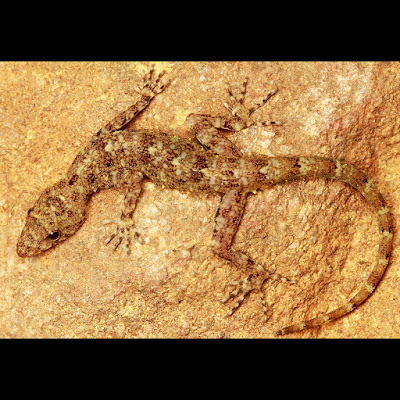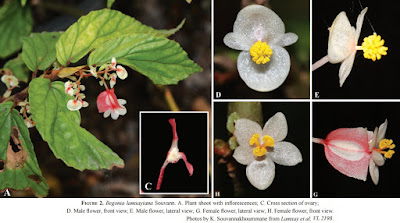[Most Recent Entries] [Calendar View]
Wednesday, September 14th, 2016
| Time | Event | ||||
| 2:59a | [Herpetology • 2016] Cnemaspis rajakarunai • A Rock Dwelling Day-Gecko (Gekkonidae: Cnemaspis) from Salgala, an unprotected Lowland Rainforest in Sri Lanka
Abstract A new species of Cnemaspis, Cnemaspis rajakarunai sp. nov. is described and is the fourth rock dwelling species belonging to the genus known from Sri Lanka. The new species is readily distinguished from all other congeners by the following combination of characters: adult snout–vent length 36–40 mm; precloacal pores absent, large femoero-precloacal scales 22; femoral pores 7–8, enlarged femoral scales 6; ventral scales 146–186; supralabials (to midorbital position) 7; supralabials (to angle of jaws) 9; total lamellae on finger IV 19–22, shape of the basal lamellae on toe IV elliptical; and its unique colour pattern. The new species is recorded from Salgala Forest an unprotected lowland rain forest. Keywords: Reptilia, Endemic, new taxa, old world gecko, Sri Lanka L. J. Mendis Wickramasinghe, Dulan Ranga Vidanapathirana and R. M. Gayan Priyankara Rathnayaka. 2016. Cnemaspis rajakarunai sp. nov., A Rock Dwelling Day-gecko (Sauria: Gekkonidae: Cnemaspis) from Salgala, an unprotected Lowland Rainforest in Sri Lanka. Zootaxa. 4168(1); 92–108. DOI: 10.11646/zootaxa.4168.1.4 | ||||
| 9:22a | [Botany • 2016] Begonia lamxayiana Souvann. • A New Species (Begoniaceae) from Lao PDR
ABSTRACT Begonia lamxayiana Souvann. is described and illustrated. KEYWORDS: Begonia, new species, Lao PDR, biodiversity, Taxonomy
Distribution and ecology.— Begonia lamxayiana is endemic to Khamkeut district, Bolikhamxai province. It is known only from type locality such as valley terrains or stream banks, on shaded steep slopes in very wet primary evergreen forest, associated with Magnolia sp., Alpinia sp., Zingiber sp., Anoectochilus sp., Bamboo, and terrestrial ferns, elevation ca. 570 m. Etymology.— The epithet is in honour of Assist. Prof. Dr. Vichith Lamxay, who collected the type specimens. Notes.— This species is similar to Begonia boisiana Gagnep. (found in Vietnam) but differs by having glandular hairs on the stem (vs. glabrous), leaves with bristles on the adaxial surface (vs. glabrous), zygomorphic androecium (vs. actinomorphic) and semi-persistent bracts, margin ciliate, pale green (vs. persistent bracts, margin dentate, pale purple or white). It is similar to B. cucphuongensis H.Q. Nguyen & Tebbitt (found in Vietnam) but differs by having leaves with bristles on the adaxial surface and dense glandular hairs along the veins abaxially (vs. both surfaces glabrous), anther apex emarginated (vs. truncate to rounded), female fl owers with 5 tepals (vs. female fl owers with 3 tepals) and stigmatic band kidney-shaped and papillose (vs. stigmatic lunate). Keooudone Souvannakhoummane, Mark Hughes and Soulivanh Lanorsavanh. 2016. Begonia lamxayiana Souvann. (Begoniaceae): A New Species from Lao PDR. THAI JOURNAL OF BOTANY [วารสารพฤกษศาสตรไทย]. 8(1): 1–5. QSBG.or.th/BOT/journal/showarticle_en.as | ||||
| 9:37a | [Herpetology • 2016] A Novel Multilocus Phylogenetic Estimation reveals Unrecognized Diversity in Asian Horned Toads, Genus Megophrys sensu lato (Anura: Megophryidae) Highlights • The presence of many putative undescribed species in Megophrys sensu lato is detected; • Multiple well-supported, geographically structured major clades in Megophrys sensu lato are resolved; • A revised classification of Megophrys sensu lato is proposed; • Borneophrys is not a valid genus but rather a junior synonym of Megophrys; Abstract The horned toad assemblage, genus Megophrys sensu lato, currently includes three groups previously recognized as the genera Atympanophrys, Xenophrys and Megophrys sensu stricto. The taxonomic status and species composition of the three groups remain controversial due to conflicting phenotypic analyses and insufficient phylogenetic reconstruction; likewise, the position of the monotypic Borneophrys remains uncertain with respect to the horned toads. Further, the diversity of the horned toads remains poorly understood, especially for widespread species. Herein, we evaluate species-level diversity based on 45 of the 57 described species from throughout southern China, Southeast Asia and the Himalayas using Bayesian inference trees and the Generalized Mixed Yule Coalescent (GMYC) approach. We estimate the phylogeny using both mitochondrial and nuclear DNA data. Analyses reveal statistically significant mito-nuclear discordance. All analyses resolve paraphyly for horned toads involving multiple strongly supported clades. These clades correspond with geography. We resurrect the genera Atympanophrys and Xenophrys from the synonymy of Megophrys to eliminate paraphyly of Megophrys s.l. and to account for the morphological, molecular and biogeographic differences among these groups, but we also provide an alternative option. Our study suggests that Borneophrys is junior synonym of Megophrys sensu stricto. We provide an estimation of timeframe for the horned toads. The mitochondrial and nuclear trees indicate the presence of many putative undescribed species. Widespread species, such as Xenophrys major and X. minor, likely have dramatically underestimated diversity. The integration of morphological and molecular evidence can validate this discovery. Montane forest dynamics appear to play a significant role in driving diversification of horned toads. Keywords: Atympanophrys; Borneophrys; Gene tree discordance; GMYC; Sympatric distribution; Xenophrys Jin-Min Chen, Wei-Wei Zhou, Nikolay A. Poyarkov Jr, Bryan L. Stuart, Rafe M. Brown, Amy Lathrop, Ying-Yong Wang, Zhi-Yong Yuan, Ke Jiang, Mian Hou, Hong-Man Chen, Chatmongkon Suwannapoom, Sang Ngoc Nguyen, Tang Van Duong, Theodore J. Papenfuss, Robert W. Murphy, Ya-Ping Zhang and Jing Che. 2016. A Novel Multilocus Phylogenetic Estimation reveals Unrecognized Diversity in Asian Horned Toads, Genus Megophrys sensu lato (Anura: Megophryidae). Molecular Phylogenetics and Evolution. DOI: 10.1016/j.ympev.2016.09.004 |
| << Previous Day |
2016/09/14 [Calendar] |
Next Day >> |






